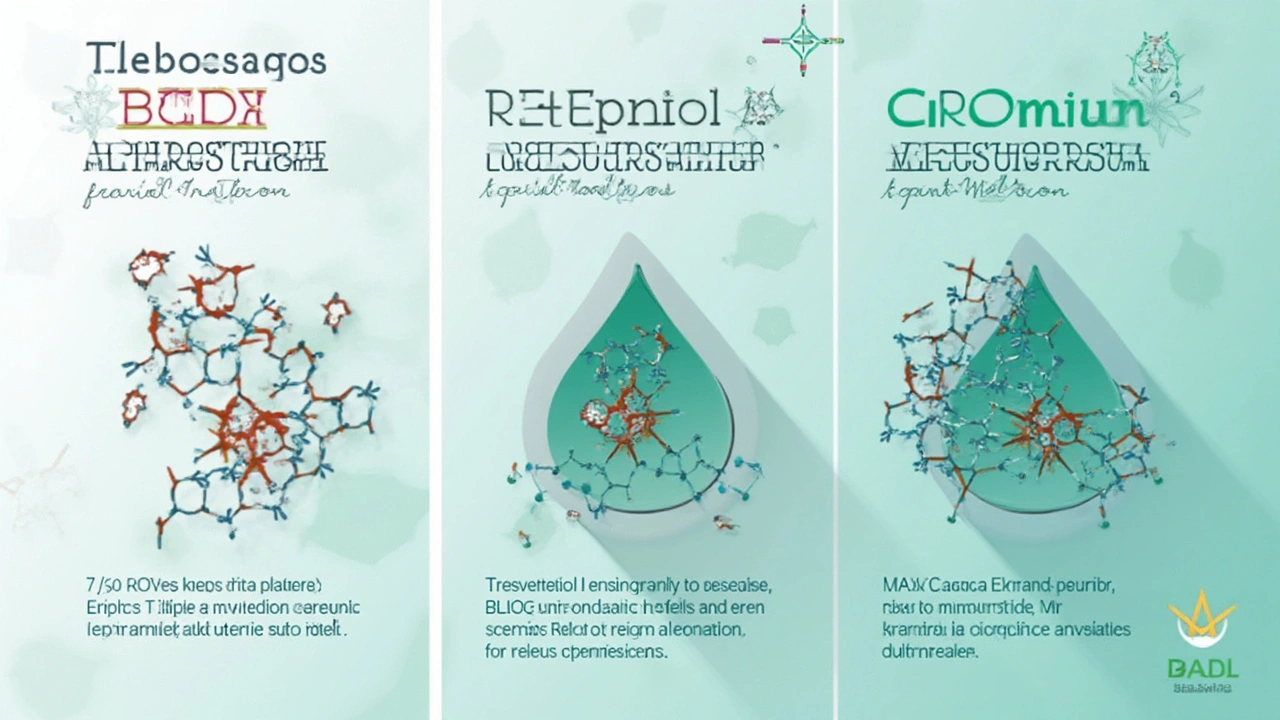Metformin is almost a household word these days, thanks to its reputation for keeping blood sugar in check and maybe even nudging the dial on aging and weight. But have you ever tried to actually get it without a script in Australia? Say goodbye to that idea. It’s locked up tight behind the pharmacy counter for good reason, but it’s left loads of people hunting for safer, non-prescription alternatives for blood sugar and energy. Turns out, a couple of everyday supplements from your local chemist or online shop aim to work on the same cellular switch Metformin is famous for: AMPK.
AMPK basically acts like your cell’s master fuel gauge. When it senses low energy, it kicks in to make your body burn sugar and fat for fuel. This isn’t abstract science—activating AMPK helps control blood sugar, cranks up fat burning, and may even slap the hand away from some age-related damage. So, if you’ve ever wanted a supplement that gives you a slice of those Metformin perks without begging your GP, here’s where to start.
How AMPK Works in Simple Terms
Let’s clear the air: cells aren’t just boring blobs. Inside every one, you’ve got this enzyme called AMP-activated protein kinase, or AMPK. It’s the boss that decides whether your cell burns sugar, stores it, or taps into your fat. When energy is low (like after exercise or fasting), AMPK comes to the rescue—telling your body to burn fuel, not store it.
Metformin’s not magic. It just triggers AMPK into action. Scientists know this isn’t only about blood sugar; AMPK also helps your muscles, liver, and fat cells stay in tip-top shape by managing energy efficiently. That’s why fitness junkies, people with prediabetes, and anti-aging buffs all keep tabs on this pathway.
So why bother with OTC supplements? Here’s the twist: some natural compounds have been shown in real research to flip on the same AMPK switch. We’re not talking about snake oil; studies show ingredients like inositol, resveratrol, and chromium can get cells humming in a similar way, without the need for a prescription.
Your body already wants to use this system. You just need the right leverage to make it work better for you.
Inositol: The AMPK Booster Hiding in Plain Sight
I used to think inositol was just some ingredient hidden in generic multivitamins. Turns out, people with PCOS and even type 2 diabetes are using it for blood sugar issues—and there’s real science backing them up. Inositol is found naturally in fruits, beans, grains, and nuts, but the supplement forms (myo-inositol and D-chiro-inositol) pack a punch. Here’s the kicker: studies out of Italy and Australia (yep, right here) show that supplementing with inositol can improve insulin sensitivity, especially for people struggling with blood sugar swing and hormonal trouble.
But how does that connect to AMPK? Researchers at the University of Perugia did a small clinical trial and found that inositol actually beefs up AMPK activity in fat cells. More AMPK means better glucose use and fat burning, less fat storage. A couple of grams a day of myo-inositol—usually split between morning and night—showed real improvement in blood sugar after just a few months.
Read ingredient labels carefully: the studies used pure myo-inositol or a mix of myo-inositol and D-chiro-inositol (the latter often at 40:1 ratio). Don’t get sidetracked by random blends—if the product doesn’t say which form, skip it.
Side note from a dad who’s tried it: inositol is virtually tasteless, so you can pour it into your coffee or smoothie without any drama. Leo, my son, once thought he’d discovered a “magic powder” for his cricket energy—until he realized I’d slipped some into his breakfast yogurt for a week. No sugar rush, just smoother energy.

Resveratrol: The Wine Molecule With Extra Benefits
If you’ve heard people talking about the “French paradox,” that’s resveratrol’s doing. It’s a compound stuck inside grape skins that’s supposed to explain why red wine drinkers can eat all the Camembert they want and still avoid heart attacks. Sure, some of that is hype, but the research on resveratrol turning on AMPK is solid.
Harvard’s David Sinclair—famous for his aging research—showed how resveratrol lights up AMPK. In his lab studies, resveratrol activated the same genes and cell switches turned on by calorie restriction and exercise, AMPK included. That’s why people take it for longevity, but blood sugar gets a real boost too.
A meta-review from 2022 combed through dozens of clinical studies and nailed down the benefits: people taking 100mg to 500mg of pure resveratrol daily saw improved fasting glucose, better insulin sensitivity, and reduced belly fat. That matches what you’d expect if AMPK was doing its thing. One catch: you won’t get the benefits just by sipping merlot. The supplement versions are way more concentrated (sometimes 50 times what’s in a glass of wine).
Tips from someone who’s tried more brands than he cares to admit: look for “trans-resveratrol” on the label, not just “resveratrol” or “Japanese knotweed extract.” Cheaper versions sometimes skip quality testing, and you’ll never feel a thing. The good news is, resveratrol’s pretty safe. Some people get a little gut upset on high doses—if that’s you, try taking it with a meal.
Chromium: The Underdog Mineral for Glucose Control
Chromium never gets as much love as vitamin D or iron, but it’s another over-the-counter staple with science behind it. Especially in Australia—the soil and water here make dietary chromium lower than you’d think. If you’re low in chromium (which is more likely if you eat lots of processed food), your insulin receptors get lazy, and glucose control goes downhill.
Science looking at AMPK and chromium? Yep, it’s there. Researchers at King’s College in London found that chromium picolinate (the best-absorbed form) raised AMPK activity in muscle cells, making them burn more sugar even at rest. In practical terms, people supplementing with 200 to 400mcg daily lowered their blood sugar spikes and saw gradual weight loss over three to six months.
A tip from my own chemist runs: skip the “mega-dose” formulas—just 200mcg is enough for most adults. Chromium is safe but, at massive doses, can upset your stomach or interact with some medications. If you’re taking diabetes meds, show the bottle to your GP before tossing it in your basket.
Want a hack? Try pairing chromium with inositol or resveratrol. One small clinical study from Melbourne tracked people who combined these (using basic, off-the-shelf brands) and saw energy and appetite swings flatten out over four weeks.

How to Put It All Together: Safe Stacking and Sneaky Tips
If you’re itching to try these, save yourself some rookie mistakes. First off, don’t start every new supplement together on day one. Test each one for at least a week solo to spot any side effects or allergies. Most people find inositol easiest on the gut, with resveratrol coming in second. Chromium only kicks up trouble at high doses.
If you’re someone who hates popping pills, inositol powder is easy to mix into pretty much anything. Resveratrol works best with breakfast if you notice any stomach rumbling. Chromium picolinate capsules are tiny—you can tuck one in next to your daily multivitamin without breaking your routine.
Here’s a power-user trick: watch your carb intake. All of these supplements work with your body’s existing AMPK system, but if you’re smashing white bread and sugary drinks all day, no amount of resveratrol is going to save you. I keep an eye on what Leo and I are eating, and if dinner looks like too much pasta, sometimes I’ll sneak in a little extra inositol just in case.
Some folks also wonder about combining these with other supplements like berberine, alpha lipoic acid, or green tea extract, which also nudge the AMPK pathway. While the science is there, everyone’s body is different—track your energy, sleep, and blood sugar for a month. Trust your own results more than a flashy label or a single influencer post.
If you want even more options, there’s a smart roundup of different supplements on this page about a non-prescription alternative to Metformin. You’ll see how these stack up and why some folks are mixing and matching a few of them. The cool bit? Most of these ingredients are familiar, easy to source, and have more research behind them than the latest “miracle tablet.”
Don’t forget regular movement helps all these supplements work better—think of a brisk walk with your dog Max, or chasing the kids around the backyard. AMPK gets cranked up naturally by exercise, so you can magnify everything these supplements do with a simple walk after meals or a quick gym session. And if you want to squeeze in an upgrade, swap your typical snacks for nuts (especially almonds and walnuts), which come with inositol and natural plant polyphenols to back up your new stack.
Bottom line, AMPK’s not some mystery code you have to hack. With the right OTC supplements like inositol, resveratrol, and chromium, plus small tweaks to your day, it’s possible to shape your energy and sugar levels without a script. Just keep it smart, dose low at first, and listen to your body. Who knows—you might even wind up with more energy than your dog. Not that Max would ever admit that.



